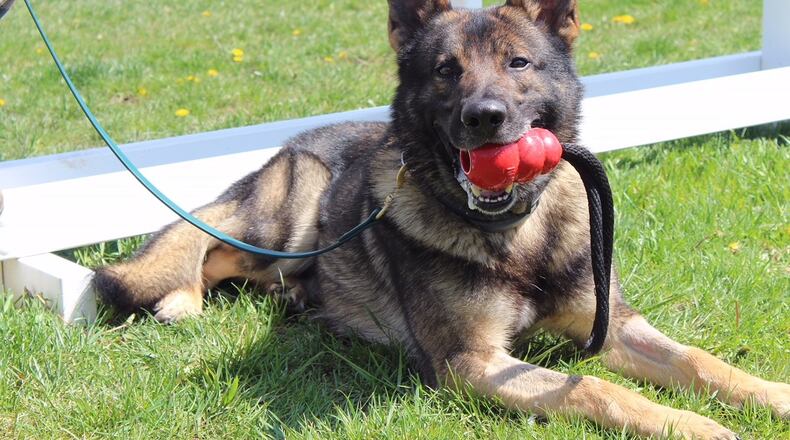Air Force MWDs are obtained from a breeding program at the 341st Training Squadron Department of Defense Military Working Dog Center on Joint Base San Antonio-Lackland, Texas. The primary breeds of MWDs in the Air Force are Dutch Shepherds and Belgian Malinois.
“MWDs will go through training just like we do and will learn basic MWD skills,” said Staff Sgt. Ashley Albright, 88 SFS MWD trainer. “After they are trained, the MWDs are sent to an installation where beside deployments, they will stay until the end of their career. Once they arrive, we will then maintain that training and advance it.”
The 88 SFS kennel, located near Bass Lake in Area A, houses five military working dogs and is staffed by six handlers, two trainers and one kennel master. The ages of the dogs range from 3 to 9 years old. The primary role of the MWDs at Wright-Patterson AFB is to protect the installation by being a viewable psychological deterrent as well as support any U.S. Secret Service missions and be ready for deployment.
“Unlike the old patrol-only working dogs who were trained on only-patrol tasks, we are a force multiplier as these assets are meticulously trained and are dual certified in various specialties,” said Master Sgt. Gabriel Travers, 88 SFS kennel master.
All the MWDs at the kennel are trained in both patrol and detection. They are capable of detecting explosives and narcotics as well as locate a person, whether it is to find a suspect or a missing person.
To become a MWD handler, potential handlers must first have experience in Security Forces and obtain a recommendation from a kennel master before they can be considered for the position. Once selected, they are sent to Joint Base San Antonio-Lackland to learn MWD patrol, basic training, detection and first aid.
For an MWD and handler, the day starts off with the handler conducting a head-to-toe health check of their dog to ensure they have no lacerations or other physical issues. Dogs are groomed and bathed if needed.
If any medical issues are found, the handler is responsible for taking their dog to the veterinarian on base or to the local emergency clinic if it is after hours. Handlers are trained to provide first aid such as wound care, heat stress and hypothermia. Handlers can also administer CPR and intravenous therapy to stabilize the dog.
After the health check, handlers will then take their MWDs out on patrol or stay at the kennel to train. Detection is one of the types of training that MWD teams consistently work on. MWDs train a minimum of three times a week on detection and are required to maintain a 90 percent to 95 percent accuracy rating on nine different types of substances.
At the end of the day, before returning to their kennel, handlers will feed the dogs and conduct another health check. To ensure the MWDs are always safe and healthy during the overnight hours, every four hours other handlers or members of 88 SFS will check in on the dogs.
“Handlers will sometimes take their dogs out on a run or will play fetch with their favorite toy, a Kong,” said Albright. “Although they are trained MWDs, we still let them be a dog every now and then and play.”
Albright said being a MWD handler and trainer has been a humbling experience and is proud of what she and the other handlers do on a daily basis. Not only do they ensure the safety of the people and property on the installation, MWDs and their handlers also work with other agencies such as the Federal Bureau of Investigation, Secret Service and Central Intelligence Agency to provide detection services.
“Before you decide to become a MWD handler, you have to be willing to accept the daily requirements of the job,” said Senior Airman Marshall Freeman, 88 SFS MWD handler. “This is not a 9-to-5 job; you have to be available 24/7. Your family also has to be understanding that you may need to take off at any moment, whether it is to go out on detection or to take the dog to the vet for a medical issue. I probably spend more time here than I do at home.”
New to being a MWD handler, Freeman has been a handler for about a year and is partnered with Sonny, who has been here for about six months. Since Sonny’s arrival, Freeman and Sonny have been working on strengthening their partnership.
“We are learning as we go. One day it could be him messing up and another day it could be me, so we are learning together on how to become a team,” said Freeman.
Once it has been determined that a MWD needs to retire because of age or a medical condition, the dog is then placed up for adoption. Most of the time, retired dogs will be adopted by a handler. Current or previous dog handlers are given priority to adopt when a dog they have worked with retires.
“MWD handlers have a connection with their dogs that no one will understand unless you have done it,” said Albright. “They rely on you and you rely on them, and they are treated just as equally as our other members in Security Forces.”
About the Author
